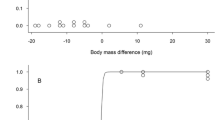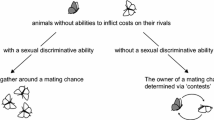Summary
-
1.
The mating system of the black swallowtail butterfly, Papilio polyxenes, was studied near Brooktondale, Tompkins County, New York, USA. Butterflies were marked individually during 8 broods from 1972 through 1976.
-
2.
Males perched within restricted areas of approximately 75 m2 and aggressively chased conspecific males that approached the area. These areas constitute territories since males maintained exclusive use of the areas 95% of the time through these encounters.
-
3.
Males defended areas of high relative elevation and topographic distinctness, but did not defend resources such as sites for oviposition, feeding, or roosting.
-
4.
Success in defending a territory depended on the number of competitors and the male's previous success but not on the size of the male. Males that emerged early in the brood were more likely to defend a preferred territory.
-
5.
The clumped distribution of territories produced lek-like male assembly areas. Females released at a distance flew to these areas and circled until they encountered a male.
-
6.
The most desirable territory, as measured by frequency of occupancy or male-male encounter rate, had the highest female visitation rate. Territorial defense reduced interference from conspecific males during courtship. Nearly 80% of the successful courtship flights were confined to a male's territory or nearby undefended areas.
Similar content being viewed by others
References
Alcock J (1981) Lek territoriality in the tarantula hawk wasp Hemipepsis ustulata (Hymenoptera: Pompilidae). Behav Ecol Sociobiol 8:309–317
Alexander RD (1961) Aggressiveness, territoriality, and sexual behavior in field crickets (Orthoptera: Gryllidae). Behaviour 17:130–223
Baker RR (1972) Territorial behaviour of the nymphalid butterflies, Aglias urticae (L.) and Inachis io (L.). J Anim Ecol 41:453–469
Bradbury JW (1977) Lek mating behavior in the hammerheaded bat. Z Tierpsychol 45:225–255
Bradbury JW (1981) The evolution of leks. In: Alexander RD, Tinkle DW (eds) Natural selection and social behavior: recent research and new theory. Chiron Press, Newton, MA
Brower LP (1959) Speciation in butterflies of the Papilio glaucus group II. Ecological relationships and interspecific sexual behavior. Evolution 13:212–228
Clark AH (1932) The butterflies of the District of Columbia and vicinity. US Nat Mus Bull 157:1–337
Davies NB (1978) Territorial defense in the speckled wood butterfly (Parage aergeria): the resident always wins. Anim Behav 26:138–147
DeVries PJ (1980) Observations on the apparent lek behavior in Costa Rican rain forest Perrhybrids pyrrha Cramer (Pieridae). J Res Lepid 17:142–144
Douwes P (1975) Territorial behavior in Heodes virgaureae L. (Lep., Lycaenidae) with particular reference to visual stimuli. Norw J Entomol 22:143–154
Emlen ST (1976) Lek organization and mating strategies in the bullfrog. Behav Ecol Sociobiol 1:283–313
Emlen ST, Oring LW (1977) Ecology, sexual selection, and the evolution of mating systems. Science 197:215–223
Feeny P (1976) Plant apparency and chemical defense. Rec Adv Phytochem 10:1–40
Gilbert LE (1976) Postmating female odor in Heliconius butterflies: a male-contributed antiaphrodisiac? Science 193:419–420
Guppy R (1962) Collecting Oeneis nevadensis (Satyrinae) and other genera on Vancouver Island, with a theory to account for hilltopping. J Lepid Soc 16:64–66
Hidaka T, Yamashita K (1975) Wing color pattern as the releaser of mating behavior in the swallowtail butterfly, Papilio xuthus L. (Lepidoptera: Papilionidae). Appl Entomol Zool 10:263–267
Hölldobler B (1976) The behavioral ecology of mating in harvester ants (Hymenoptera: Formicidae: Pogonomyrmex). Behav Ecol Sociobiol 1:405–423
Lederhouse RC (1978) Territorial behavior and reproductive ecology of the black swallowtail butterfly, Papilio polyxenes asterius Stoll. PhD dissertation, Cornell University, Ithaca, NY
Lederhouse RC (1981) The effect of female mating frequency on egg fertility in the black swallowtail butterfly, Papilio polyxenes asterius Stoll (Papilionidae). J Lepid Soc (in press)
Lederhouse RC, Finke M, Scriber JM (1982) The contributions of larval growth and pupal duration to protandry in the black swallowtail butterfly, Papilis polyxenes. Oecologia (Berl) (in press)
Lloyd JE (1973) Fireflies of Melanesia: bioluminescence, mating behavior, and synchronous flashing (Coleoptera, Lampyridae). Environ Entomol 2:991–1008
Powell JA (1968) A study of area occupation and mating behavior in Incisalia iroides (Lepidoptera: Lycaenidae). NY Entomol Soc 76:47–57
Rawlins JE (1980) Thermoregulation by the black swallowtail butterfly, Papilio polyxenes (Lepidoptera: Papilionidae). Ecology 61:345–357
Rawlins JE, Lederhouse RC (1978) The influence of environmental factors on roosting in the black swallowtail, Papilio polyxenes asterius Stoll (Papilionidae). J Lepid Soc 32:145–159
Scott JA (1974) Mate-locating behavior of butterflies. Am Midl Nat 91:103–117
Scott JA (1975) Mate-locating behavior of western North American butterflies. J Res Lepid 14:1–40
Shapiro AM (1966) Butterflies of the Delaware Valley. Am Entomol Soc, Spec Pub, 79pp
Sheppard JH (1966) A study of the hilltopping behavior of Pieris occidentalis Reakirt (Lepidoptera: Pieridae). Pan-Pac Entomol 42:287–294
Shields O (1967) Hilltopping. J. Res Lepid 6:69–178
Shields O, Emmel JF (1973) A review of carrying pair behavior and mating times in butterflies. J Res Lepid 12:25–64
Sims SR (1979) Aspects of mating frequency and reproductive maturity in Papilio zelicaon. Am Midl Nat 102:36–50
Southwood TRE (1966) Ecological methods, with particular reference to the study of insect populations. Metheun, London
Spieth HT (1968) Evolutionary implications of sexual behavior in Drosophilia. Evol Biol 2:157–193
Suzuki Y (1976) So-called territorial behavior of the small copper, Lycaena phlaeas daimio Seitz (Lepidoptera, Lycaenidae). Kontyu 44:193–204
Suzuki Y, Nakanishi A, Shima H, Yata O, Saigusa T (1977) Mating behavior of four Japanese species of the genus Pieris (Lepidoptera: Pieridae). Kontyu 45:300–313
Tietz HM (1972) An index to the described life histories, early stages, and hosts of the macrolepidoptera of the continental United States and Canada. Allyn, Sarasoto, FL
Tyler HA (1975) The swallowtail butterflies of North America. Naturegraph, Healdsburg, CA
Wiklund C (1977) Courtship behaviour in relation to female monogamy in Lepidea sinapis (Lepidoptera). Oikos 29:275–283
Author information
Authors and Affiliations
Rights and permissions
About this article
Cite this article
Lederhouse, R.C. Territorial defense and lek behavior of the black swallowtail butterfly, Papilio polyxenes . Behav Ecol Sociobiol 10, 109–118 (1982). https://doi.org/10.1007/BF00300170
Received:
Accepted:
Issue Date:
DOI: https://doi.org/10.1007/BF00300170




